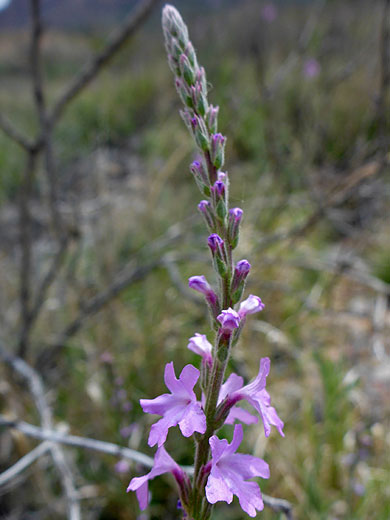Common name:
Gray vervain
Family:
Scientific name:
Verbena canescens
Main flower color:
Range:
Texas; introduced to small areas of California and Nevada
Height:
Up to 16 inches
Habitat:
Canyons, foothills; 2,000 to 6,000 feet
Leaves:
Stalkless, opposite, lanceolate, up to 2 inches long and 0.7 inches wide
Season:
April to October
The species name of verbena canescens refers to the fine, variable-length, grayish-white hairs (canescence) that cover the stems, leaves and calyces. Stems are square in-cross-section and bear narrow, lance-shaped leaves at opposite intervals. Leaves are lined with large teeth, or shallow lobes.
The inflorescence occupies several inches at the top of the stem. Flowers are subtended by a pointed, green, ovate bract, quite well separated from the reddish-green calyx, which is around 0.1 inches in length and has five small lobes. The corolla is twice as long as the calyx, colored pinkish purple to blue, with five lobes, two upper and three lower. The corolla lobes have a shallow notch at the tip.
The inflorescence occupies several inches at the top of the stem. Flowers are subtended by a pointed, green, ovate bract, quite well separated from the reddish-green calyx, which is around 0.1 inches in length and has five small lobes. The corolla is twice as long as the calyx, colored pinkish purple to blue, with five lobes, two upper and three lower. The corolla lobes have a shallow notch at the tip.
All Contents © Copyright The American Southwest | Comments and Questions | Contribute | Site Map



